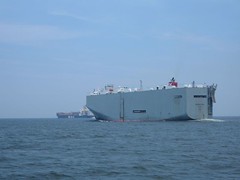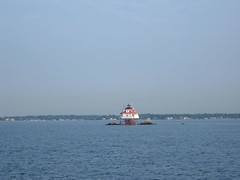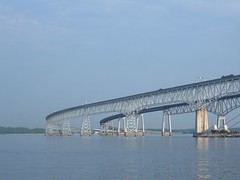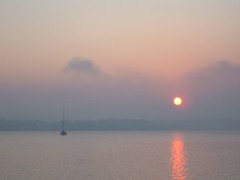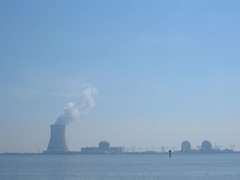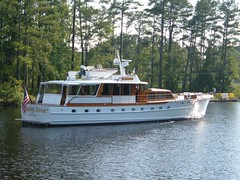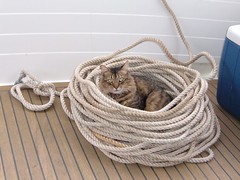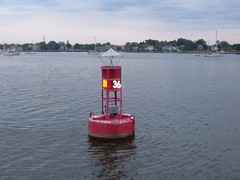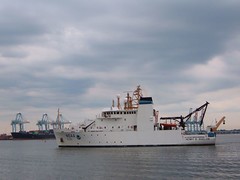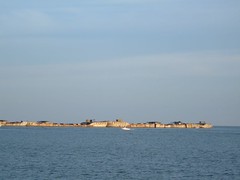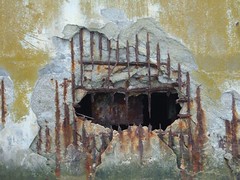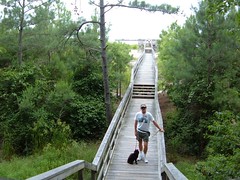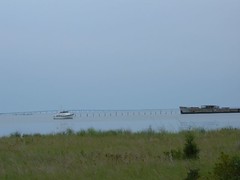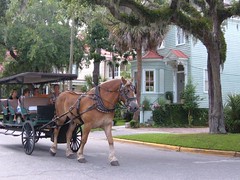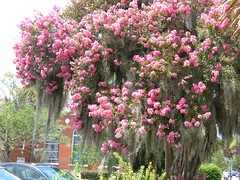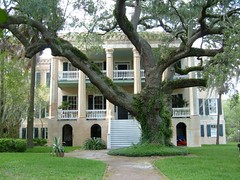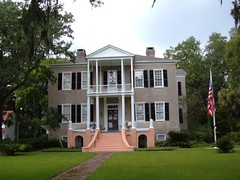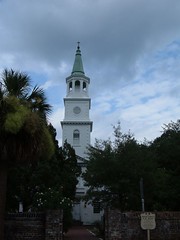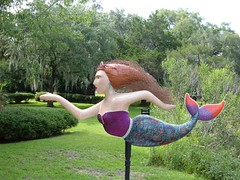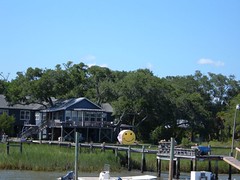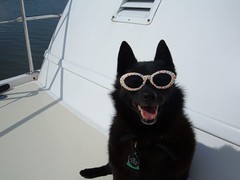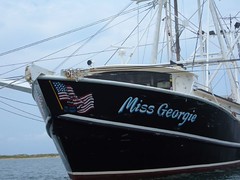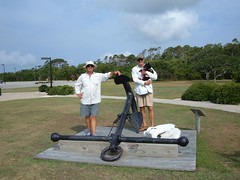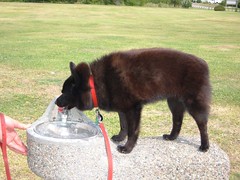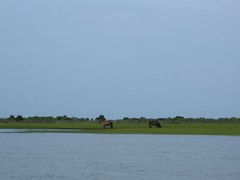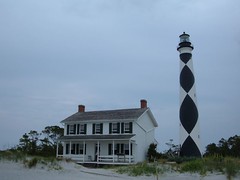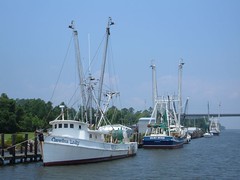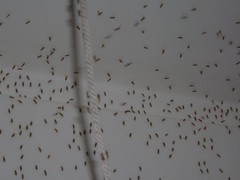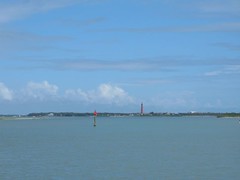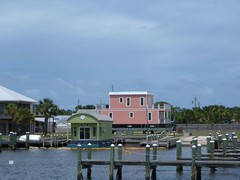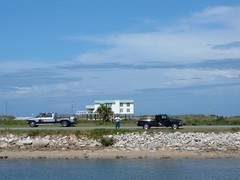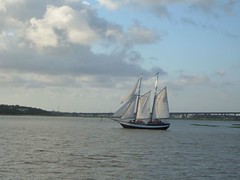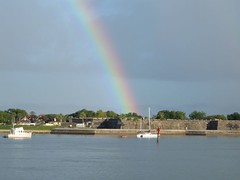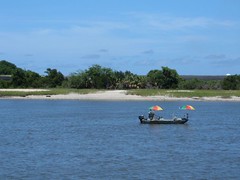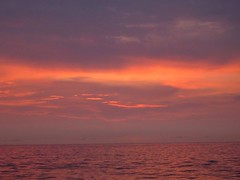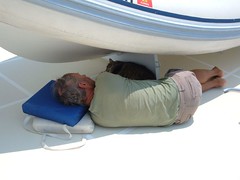Heading Up and Down the Bays, and Washed Out to Sea
July 14-17, 2007
Getting up at 0630 on the 14th was a treat since the original plan called for a 0100 wake-up call. Since our coastal run was scratched we will have a short day (7 hrs) to get to our anchorage at Sandy Point at the mouth of the Great Wicomico River. After anchoring, Wayne and Eddie decide to get out the old alternator to replace the one we are operating with now since it has been discovered it is not putting out ANY voltage now, and our batteries are almost dead. They can't make the change over until everything cools down when we turn off the engine after we anchor. I decide to make brownies and vacuum the inside of FLUKE. The old alternator change over proves to be successful; even though we will have less output, it will be better than zero. We will have the alternator checked when we get to a convenient land base. Looking through the binoculars towards the shoreline I can see a 10' tall carving of a pilgrim that looks like it was made out of a gigantic tree trunk. Fascinating, as it is private property and not a park.
Calm waters of July 15 allowed me to work on the blog while underway to our destination in the Rhode River, south of Annapolis, MD. The Rhode was so crowded with both sail and power boats. However, one of the nice things about that river is it has a "through" section of the waterway designated as a float free zone. The Chesapeake is notorious for crab traps and their buoys making navigation very difficult in some areas. Whoever managed to get the float free zones created has done a real service for safety and enjoyment of the waterway. We would like to see more of those zones, especially in Maine.
Early the next day we passed the picturesque Thomas Point Light and then slowly cruised under the huge William P. Lane Memorial Bridge (Land Rt. 50/301). It is the only full bridge connecting both sides of Chesapeake Bay so has to be high enough for all the military and commercial ships to go under. It sure looks a lon . . . .g way up as we go under!
It must have been Demolition Day at the Aberdeen Proving Ground where the Army does ordnance testing. There was one explosion after another, varying in amount of noise and smoke plumes produced, as we passed by. There are "guard" boats stationed out in the waterway making sure that no one can get to close to "ground zero".
We dropped anchor just inside the mouth of the Bohemia River, west of the beginning of the C&D Canal, early enough for Eddie to go for a float behind the boat. He puts out a line with a float to hold onto and the current pulls him back out behind the boat. He can flounder around in the water or sit on the float. The big deal about this is that this is one of the rare areas in the Chesapeake "back" waters people can swim without having to worry about sea nettles stinging them. We have seen numerous types of jellyfish at several of the anchorages we have visited. Some of them have tentacles a couple of feet long!
We are entertained watching 3 people crabbing right next to us. Using a small skiff, they run out a line about 100 yds long with an anchored float at each end. A piece of bait is securely attached to the line about every 10 yds. Starting at one end the line is lifted out of the water and the boat is driven alongside the line. As the line comes up out of the water, hopefully with a crab grabbing the bait, a person with a metal net scoops the crab off and dumps it in the boat. When the boat gets to the other end, they turn around and go back to the beginning. By the time they begin lifting the line more crabs have gone after the bait again. We were impressed with how many crabs they were catching in a short period of time.
We could see weather conditions were building up for some rain and fog, so we weren't surprised to wake up on July 17 to a foggy sunrise. With visibility less than 100' in some places and the current against us, traveling through the sometimes restrictive C&D Canal was a slow venture. We relied on our radar to look for other ships (those coming from behind are just as worrisome) and hailer siren to provide an audible warning.
Fortunately when we entered Delaware Bay most of the fog had lifted, the Bay was calm, and traveling just outside the main shipping channel (this is done to give the BIG commercial ships all the room), we made good progress towards the Atlantic. In fact, with a weather forecast of only patchy fog, mild winds and mostly calm seas we made the decision not to stop at Cape Henlopen and just keep going all night up the coast of New Jersey to beat what looked like impending foul weather.
The wind and sea conditions proved to be true to the forecast, but the fog was not patchy within the 10 or less miles we traveled from the coast; it was socked in. We kept thinking that we would get out of it, but as the twilight waned it stayed with us. This was to be our first experience with traveling in the fog at night. Night travel at sea is challenging enough in my book, but the fog added a whole new fear.
I had the first watch, from 2000-0045. The foggy black of night disoriented my depth perception. Even though I had the radar and electronic chart to guide me it is still an unsettling feeling not to actually see a target. I tracked a boat for 4 miles that was slowly angling towards our course and felt comfortable that it was seeing me too by its course line, but I couldn't see it until it was less than 1/4 mile away when I saw that it was a fishing boat with nets out. If it had been a boat traveling at twice our speed I would have been very nervous since that short distance would have been passed quickly.
In fact, at 2230 I had a marker buoy coming up that I could see on radar and on the chart. When I could finally see it flashing through the fog I felt we were going to be too close and turned the boat off course. I had difficulty orienting myself and had to wake up Wayne to come help me. Eddie woke up too. I felt so bad disrupting their sleep! Little did I realize what they were going to do to me when it was my turn to finally get some much-needed rest.
At 0345 I was awakened to a loud grinding noise coming from the aft section of FLUKE, and the boat was getting bounced around quite a bit, not like when I left the helm and the seas had been calm. I thought we had hit something with the prop. I could hear Eddie yelling up in the pilothouse. I ran upstairs to see the guys staring out at a commercial fishing boat that had crossed right in front of our bow. Wayne had put the boat in reverse to bring her to a stop to avoid a collision. Even though they had tracked the boat for quite a ways, and we had the right-of-way, the other boat had not yielded. They had misjudged the distance it would take to alter course to avoid the other boat by a comfortable margin. Another lesson learned a frightening way. It was difficult to go back to sleep after that!
The fog stayed with us all the way up to Sandy Hook at the northern tip of New Jersey where we would make the turn to head up into busy New York harbor. With visibility being so poor, and the air feeling like impending rain, we decided to hold off going into the harbor until the conditions improved. Having to deal with the fast moving NYC ferry traffic in the fog wasn't what we wanted to practice. Plus, it gave us a chance to check out the Horseshoe Cove anchorage which we had never been to and wanted to find out if it would be suitable to use after the NJ coastal run in the future. We had the anchor down at 0800 and breathed a sigh of relief.
Tuesday, July 24, 2007
Monday, July 23, 2007
Great Bridge, VA to Chesapeake Bay
The Great Deal
July 11-12, 2007
We weren't arrested, fined or kicked off for exceeding the 24 hour limit at the Great Bridge free dock as we spent the nights of July 11 and 12. We didn't feel guilty about over extending the time limit since no other boats docked on the south side of the bridge anyway. A couple of boats did use the dock on the north side though.
The bridge and lock land areas have been turned into a park. People come to crab, fish, and just watch the recreational and commercial boats, tugs, and barges slowly travel through the lock and bridge area. It is a great way to watch the ICW traffic since you can get so close using the observation areas along the shore; you can talk to people on the vessels passing without even yelling. 35,000 cars/day travel over the bridge.
There is a flock of Canadian geese that has one domestic goose and her 3 goslings traveling with them. It looks funny to see the one odd goose in with all the others. They are all beggars and make goose poop piles reflective of their big body size, and it is all over the shore where we have to walk.
A Farm Fresh grocery store about a mile down the road makes it convenient for us to shop for perishable items we have run out of. The only challenge is carrying everything back to FLUKE, especially deciding who has to carry the watermelon and cantaloupe. We reward ourselves with a trip to the nearby Dairy Queen. The cute guy behind the counter sees Ursa peering through the window and hands me a small cup with vanilla ice cream saying, "This is for your dog". Eddie rode his bike to a NAPA store about 5 miles away, risking life and limb along the concrete jungle road with no bike path, to pick up the oil filters we needed for the engine.
Eddie received some sad news at this stop. He was to rendezvous with Mrs. Clark, a former tenant of Sea Oaks. He had started calling her a couple of days before we arrived and couldn't get an answer. Her daughter saw the message and returned Eddie's call to tell him that her mother had died two weeks earlier and that she had it written on her calender to meet with Eddie. We were sorry she missed our boat.
A Good Luck, Friday the 13th, Sunrise Over Norfolk
July 13, 2007
We had to get off the free dock by 0445 so we could get through all four of the Norfolk bridges before they shut down for 2 hours beginning at 0630 for morning rush hour traffic. We were through "our" great bridge and into the Great Bridge Lock (separates the fresh water of the lowland areas from salt water of the Norfolk side) by 0500. Since we were the only ones in the lock and there was hardly any tide we went through quickly. Then it was a rush to get to all the bridges in time.
There was virtually no waterway traffic to impede our progress. A couple of tugs were moving around, presumably to get hooked up with their cargo somewhere. We passed through the old (1928) Jordon Lift bridge, our last one, with 5 minutes to spare. Then we were in the downtown part of the Portsmouth harbor area and passed into the Norfolk Navy section. It was interesting being alone in this usually busy, congested area. We could see people arriving to work and Navy personnel assembled on many of the ships in group formation for their morning "check in". We slowly pass by red buoy 36, mile 0 of the ICW. You would think there would be a sign saying that! The home dock is close to mile marker 950, so you can see we have come a long way.
We had our anchor set in the Kiptopeke State Park anchorage area by 1100. This anchorage is one of the most unique we have visited. KSP is the only state park located on Virginia's eastern shore. The land was originally the site of the terminus of the ferry which provided service from 1950 - 1964 connecting Virginia's eastern shore to Norfolk before the construction of the Chesapeake Bay Bridge Tunnel. The terminus needed a breakwater to help ensure safe ferry landings in poor weather. So, the Virginia Ferry Corporation purchased nine surplus WWII concrete Liberty ships. They were sunk, filled with sand and water and lined up in a 1500' long row. The breakwater did its job; the ferry service provided up to 90 trips/day at its peak.
When the new bridge forced the ferry service to shut down, the 540 acre site was purchased by the State of Virginia for a park. The name Kiptopeke means "Big Water", which is what the ferry had to cross each day. Now the site has multiple uses for people to enjoy. The old terminal platform is a huge fishing pier complete with dual boat launch ramps. There is a swimming beach, 4 miles of hiking trails, bird banding site (thousands of migratory birds stop in the fall and spring), hawk and raptor observation station, butterfly garden, and campground. The old breakwater provides an excellent fish habitat for sport fishermen to enjoy trying their luck. After lunch we launched FIN so we could go ashore to check out the land facilities and get some walking exercise.
We anchored here with the intent of exiting out of the south end of Chesapeake Bay and making an 18 hr. Atlantic Ocean run up the eastern coast of Virginia to Cape Henlopen where we would stage ourselves to cross the Delaware River to go up the coast of New Jersey. A late afternoon weather forecast indicated that sea conditions didn't look favorable in 3 days when we would be out to sea, and we didn't want to be stuck just sitting at Cape Henlopen, so we have changed our plans and will head up inside Chesapeake Bay. Such flexibility will keep our tummies happier.
July 11-12, 2007
We weren't arrested, fined or kicked off for exceeding the 24 hour limit at the Great Bridge free dock as we spent the nights of July 11 and 12. We didn't feel guilty about over extending the time limit since no other boats docked on the south side of the bridge anyway. A couple of boats did use the dock on the north side though.
The bridge and lock land areas have been turned into a park. People come to crab, fish, and just watch the recreational and commercial boats, tugs, and barges slowly travel through the lock and bridge area. It is a great way to watch the ICW traffic since you can get so close using the observation areas along the shore; you can talk to people on the vessels passing without even yelling. 35,000 cars/day travel over the bridge.
There is a flock of Canadian geese that has one domestic goose and her 3 goslings traveling with them. It looks funny to see the one odd goose in with all the others. They are all beggars and make goose poop piles reflective of their big body size, and it is all over the shore where we have to walk.
A Farm Fresh grocery store about a mile down the road makes it convenient for us to shop for perishable items we have run out of. The only challenge is carrying everything back to FLUKE, especially deciding who has to carry the watermelon and cantaloupe. We reward ourselves with a trip to the nearby Dairy Queen. The cute guy behind the counter sees Ursa peering through the window and hands me a small cup with vanilla ice cream saying, "This is for your dog". Eddie rode his bike to a NAPA store about 5 miles away, risking life and limb along the concrete jungle road with no bike path, to pick up the oil filters we needed for the engine.
Eddie received some sad news at this stop. He was to rendezvous with Mrs. Clark, a former tenant of Sea Oaks. He had started calling her a couple of days before we arrived and couldn't get an answer. Her daughter saw the message and returned Eddie's call to tell him that her mother had died two weeks earlier and that she had it written on her calender to meet with Eddie. We were sorry she missed our boat.
A Good Luck, Friday the 13th, Sunrise Over Norfolk
July 13, 2007
We had to get off the free dock by 0445 so we could get through all four of the Norfolk bridges before they shut down for 2 hours beginning at 0630 for morning rush hour traffic. We were through "our" great bridge and into the Great Bridge Lock (separates the fresh water of the lowland areas from salt water of the Norfolk side) by 0500. Since we were the only ones in the lock and there was hardly any tide we went through quickly. Then it was a rush to get to all the bridges in time.
There was virtually no waterway traffic to impede our progress. A couple of tugs were moving around, presumably to get hooked up with their cargo somewhere. We passed through the old (1928) Jordon Lift bridge, our last one, with 5 minutes to spare. Then we were in the downtown part of the Portsmouth harbor area and passed into the Norfolk Navy section. It was interesting being alone in this usually busy, congested area. We could see people arriving to work and Navy personnel assembled on many of the ships in group formation for their morning "check in". We slowly pass by red buoy 36, mile 0 of the ICW. You would think there would be a sign saying that! The home dock is close to mile marker 950, so you can see we have come a long way.
We had our anchor set in the Kiptopeke State Park anchorage area by 1100. This anchorage is one of the most unique we have visited. KSP is the only state park located on Virginia's eastern shore. The land was originally the site of the terminus of the ferry which provided service from 1950 - 1964 connecting Virginia's eastern shore to Norfolk before the construction of the Chesapeake Bay Bridge Tunnel. The terminus needed a breakwater to help ensure safe ferry landings in poor weather. So, the Virginia Ferry Corporation purchased nine surplus WWII concrete Liberty ships. They were sunk, filled with sand and water and lined up in a 1500' long row. The breakwater did its job; the ferry service provided up to 90 trips/day at its peak.
When the new bridge forced the ferry service to shut down, the 540 acre site was purchased by the State of Virginia for a park. The name Kiptopeke means "Big Water", which is what the ferry had to cross each day. Now the site has multiple uses for people to enjoy. The old terminal platform is a huge fishing pier complete with dual boat launch ramps. There is a swimming beach, 4 miles of hiking trails, bird banding site (thousands of migratory birds stop in the fall and spring), hawk and raptor observation station, butterfly garden, and campground. The old breakwater provides an excellent fish habitat for sport fishermen to enjoy trying their luck. After lunch we launched FIN so we could go ashore to check out the land facilities and get some walking exercise.
We anchored here with the intent of exiting out of the south end of Chesapeake Bay and making an 18 hr. Atlantic Ocean run up the eastern coast of Virginia to Cape Henlopen where we would stage ourselves to cross the Delaware River to go up the coast of New Jersey. A late afternoon weather forecast indicated that sea conditions didn't look favorable in 3 days when we would be out to sea, and we didn't want to be stuck just sitting at Cape Henlopen, so we have changed our plans and will head up inside Chesapeake Bay. Such flexibility will keep our tummies happier.
Wednesday, July 11, 2007
Beaufort, SC to Great Bridge, VA
Taking and Giving
July 3, 2007
Beaufort was founded in 1710 making it the second oldest city in South Carolina. Cash crops of rice, cotton and indigo helped the town prosper and become an aristocratic center. Wealthy landowners and merchants built many beautiful mansions of various architectural styles.
When the Civil War broke out, Beaufort was taken over by the Union army and navy. As tragic as it was at the time, the take over was what kept Beaufort in tact. The Union used the town as the federal base of the south, and so when General Sherman made his famous “March to the Sea”, destroying all towns in his path, Beaufort was spared. The beautiful well-preserved, varied buildings were left undamaged to be enjoyed in all their current glory.
The best way to see the town is to take a walking tour using the $2.95 map you can buy at the Visitor Center or ride in a horse drawn carriage with narration by the driver. Both ways will give you a slow enough pace to get a real flavor for the well preserved mansions and period homes in the beautiful tree canopied setting. We took the walking tour, despite Eddie's whining to take the carriage tour (he had a pony when he was 7 and still has a tendency to revert back to that time), since we needed the exercise after being FLUKE-bound for 5 days. Despite being a hot day, all the trees and the breeze from the nearby Beaufort River, kept the walk pleasant.
A few of our favorite sites included the following:
The Castle, 1850, is one of the most photographed homes in America. It is an unusual medieval style, solid brick, antebellum mansion overlooking the ICW.
The Thomas Fuller House, 1786, is a perfectly preserved example of Tabby construction. Lime, oyster shells, and sand, all cheap materials easy to come by, were mixed together to make the Tabby “cement”.
St. Helena's Episcopal Church, 1712, served as a hospital during the Civil War. It is said that the tombstones in its surrounding cemetery were used as operating tables. The fascinating perimeter wall is constructed of bricks which were used as ballast on English ships.
The Taub House has to get the prize for being the most outwardly patriotic, both front and back.
Henry C. Chambers Waterfront Park has just been completed and is a wonderful example of a waterfront showcase to draw people to an area. The winding paths, planters, bench swings, shops, restaurants, green space, and unique children's play area offer much versatility for private and public use. Contiguous to the park is the Downtown Marina with its free (that always gets our attention!) floating dock where boaters can tie up for day dockage to shop and tour.
The entire downtown area has been designated as a historic district by the National Trust for Historic Preservation. The storefronts with all their shapes, colors, and architectural features make for an interesting walk to shop in a boutique, specialty shop, and even old time department store. We had to stop at the Chocolate Tree which was where Forrest Gump bought his box of chocolates. One attorney's office had glass plates put in the new walls, built over the original, so you can look in and see what the original Tabby walls looked like.
The beautiful mermaids caught our attention. They are part of a fund raiser called the Big Swim sponsored by the Arts Council. The 31 sculptures, placed in various public areas, were decorated by local artists and depict aspects of Low Country life. They will all be auctioned off in October.
Our time was too short, and we will need to return again to catch all we missed. Beaufort is worth the stop by car or boat. You won't be disappointed!
Independence Day, 2007
July 4, 2007
We had a discussion about traveling on July 4. We figured there was a good chance there would be a lot of day boaters and many of those would be partying, possibly causing bad “waves” on the waterway. We were going to travel on the ICW from Beaufort to Winyah Bay near Georgetown, SC , and that would take 2 days for us. This isn't a bad route as far as inland waterway obstacles and it is scenic, so despite our concerns about the holiday traffic we had the anchor up by 0600 and were underway while most of the party animals were still dreaming of the fun day they had planned.
The behavior of the day boaters was better than we had expected. There weren't as many boats as we expected, but most boats had a lot more people in them than what we normally see. Even the PWCs, or fleas, as we call them were not overly annoying.
Then we reached Elliott Cut, south of Charleston, which connects the Stono River to Wappoo Creek. The old Wappoo Creek draw bridge goes over the cut, and if the tide is on the low side we can get FLUKE under it without having to request the tender open the bridge. We called the tender to ask for a water level reading under the bridge, and told her we thought we could make it with 1-2' to spare if we passed under the high part of the span. We had a strong current pushing us from behind limiting our maneuverability, and we had to make sure that no other boats were coming towards us since there was only enough room for FLUKE to pass under alone. It looked like things were good to go so Eddie proceeded to move forward. Right as we reached the bridge, the point of no return, a pontoon boat pulled out from shore on our starboard side just beyond the bridge and moved into position ahead of us. At the same time on the same side, some marine police officers pulled another boat over to the shore. The pontoon boat slowed its speed, either to look at the police activity or just to try to look like they were obeying the no wake rule, which caused FLUKE to be rapidly gaining on their stern. With the current pushing our stern we just couldn't slow our boat down and there was no room to turn away from the pontoon boat. Eddie just had to blow the horn, blow the horn, and blow the horn. To our amazement the pontoon boat driver just stared at us as we were looming closer and too many seconds passed before he finally realized that we were not going to slow down and would eat him up if he didn't move over. Our horn is a BIG ship's horn and sounds like one coming from a freighter. Many other boaters who were coming towards us began pulling over and staring at the pontoon boat. Anyone who was taking a nap within a ¼ mile of the cut had to be awakened. When the situation had stabilized we called the bridge tender to apologize for the noise, but she said she could see our predicament and wished us safe passage forward. I regret not having pictures to share, but all eyes were forward on the obstructing pontoon boat.
Shortly after that we passed through the very busy Charleston harbor which was easy compared to the Wappoo Creek area. When it wasn't Eddie's turn to man the helm he sat out on the foredeck with the glamorous Ursa, making passing boaters laugh.
We set the anchor down in an unnamed marsh creek off the ICW north of Isle of Palms. We saw over 80' of water under our keel at one point as we went up into the creek. That is pretty amazing considering we are seeing less than 3' a lot of places in the main ICW “highway”. Keeping with the holiday festivities a parasail boat sped by us (in this creek!), and I worried that the line connecting the parachute to the boat was coming too close to our mast for comfort and avoided turning FLUKE until the line was well clear and the shadow cast from the parachute was no longer next to our starboard side.
The night sky was filled with many fireworks displays from at least a dozen coastal communities. Since we were out in the eastern marsh lands bordering those towns, we could see the colorful explosions in a 180 degree western panorama from south to north.
Losers in Winyah Bay
July 5-6, 2007
Shortly after we left the unnamed creek, and were back underway on the ICW, we called the Coast Guard to report a downed ICW channel marker, still attached to its pole. It was probably a casualty from yesterday's party day. You don't knock down one of those things without doing extensive damage to your vessel and/or body unless you are a barge and then you may not even know you hit one.
Our destination was Winyah Bay. It has a Class “A” inlet which means if you have half a brain and can read channel markers you can get in and out of the inlet without needing local knowledge about possible shoaling conditions which are prevalent at most inlets. Plus, the markers are fully lighted, but we aren't going to be leaving in the dark anyway. We have never used this inlet before so we want to be able to see everything for our reference banks. We will exit out of here to the Atlantic Ocean for an overnight crossing to Cape Lookout, North Carolina.
We know that the current will be strong so we have decided to anchor bow and stern. Finding a good spot was the challenge. The most protected areas were all too shallow. We tried an area close to the shore, trying to set the Delta twice and the SuperMax once, but neither would hold the bow tight. So, we moved to a spoil area out in the middle of the channel and got the anchors to hold well. We had 3 KTs of current on our stern at full flow and the stern anchor line was like a piano wire. At least we had gotten in early enough to go through the tide change and make sure we were going to hold securely, but there was a lot of strain on the big girl and we weren't as comfortable as we would have hoped. We won't anchor out there again and have to chalk it up as another learning experience.
We were winners on the high seas the next day when we were making our 22 hour crossing to Cape Lookout. We didn't leave Winyah Bay until 1000 (after our Thursday pancakes) because we wanted to make sure that we were entering the Cape Lookout area after the sun was up high enough for us to see well. Confused, bumpy seas right out of the inlet made for an uncomfortable ride for a few hours, but they settled down later in the day and fortunately stayed nice through the darkness of night. We caught 2 dolphin with our trolling lures. Eddie and I cleaned and “processed” them, having improved our filleting skills since our Bahamian fishing adventures. We had dolphin steaks for dinner that night and have enough frozen steaks for several more big meals. Maybe if we keep eating a lot of fish we can get smarter!
Look at this Cape!
July 7-8, 2007
July 7 and 8 would find us securely anchored in the sandy bottom of spacious Lookout Bight located off the southern end of Cape Lookout National Seashore. We needed a day to recuperate from the night crossing and then another day to be tourists in this beautiful area. The locals use the area, too, because by midday on Saturday there were a couple hundred day boaters enjoying various activities such as fishing, sunbathing, beach combing, and using water toys.
Cape Lookout National Seashore exists on the sandy barrier island extending 56 miles from Ocracoke Inlet on the north end to Beaufort Inlet to the south. The park is only accessible by private boat or ferry service. Scattered sea grasses of various types help stabilize the low lying dunes on the eastern edge, while salt marsh helps buffer the waters on the western side. There are no boutiques, fashionable restaurants, or tacky tourists shops; people visit for nature only.
Our too short time here was spent doing the following:
We went swimming in the refreshing, clear water of the Bight, taking the time to scrub FLUKE's hull at the waterline. She had a good growth of algae that was giving her a shaggy appearance.
We took a long dinghy ride over to Harker's Island, location of the official visitor's center for the park. There are interpretive displays, relief dioramas, an overview film, nature trail, and picnic area. I was able to buy a postcard with an aerial view of the area where we anchored to add to our growing collection housed under the plexiglass on our storage chest coffee table in the main saloon.
We saw one of the herds of the wild horses of Shackleford Banks, part of the park land. The horses have been there for centuries, and genetic testing has indicated evidence of Spanish ancestry. A notice at the visitor's center said that in April a filly was born bringing the total number of horses to 117.
A dinghy trip across the Bight took us to the shore adjacent to the Cape Lookout lighthouse and keeper's house. This operational lighthouse, completed in 1859, stands 163' high. It is one of 7 lighthouses along North Carolina's coast. Each lighthouse has a distinctive daymark (paint job) so that mariners would be able to have an idea of their position once they could see the pattern. However, their most important job was to provide visual guidance at night, protecting sailors from the perils of the “Graveyard of the Atlantic”, the dangerous coastal area with reefs and shifting shoals. A visit to keeper's house provided insight into the solitary life the coastal keepers led. It was just a short walk through the dunes to the picturesque oceanside beach.
Eddie and Wayne performed a scheduled oil change on FLUKE's main engine only to find out we didn't have any spare oil filters to replace the old one that needed to come off. The old one was put back on with the intention of getting a new one when we stop in civilization in a couple of days. Yes, we are still having fun, but you should have heard the blame fairies buzzing around the boat when it was discovered there were no spare filters. I think we should be eating fish every night!
Compass Change Range 057 – 337
July 9, 2007
The title of this section shows the directional variation we are moving, lots of twists and turns. However, the waterway remains picturesque and mostly very rural. In fact on this night of July 9 we are anchored off a cornfield north of Bellhaven, North Carolina. There is deep enough water far enough from the ICW for us to just ease right on in toward the shore. Easy in, easy out in the morning.
Crossing the expansive Neuse River a rainstorm passed over with the usual blustery winds, but it moved quickly, and we did well. As we passed through the tiny town of Hobucken (the name even sounds rural) we slowly eased by the R.E.Mayo commercial shrimp docks. I enjoy seeing the shrimp boats tied up, the loading hoppers, and buildings associated with this working dock. Today one of the boats is being sand blasted. Passing boats get so close the blasting operation has to stop for each one that goes by or else the mess would get on us too! I think that it looks like an “evil” job to do, especially in the heat of summer.
Today we see our first oyster shell recycle center. We had read about the need to do this, but had never actually seen a site. In nature, oyster larvae need a substrate to attach themselves to, and one of the best sources are old oyster shells. Communities where oysters are a big commodity have regular drop off areas on docks. Restaurants and private individuals can drop off the shells which are picked up and taken to a recycle area. The one we saw had huge piles, big enough to have been dumped by a dump truck. It appeared to be at a dead end road in a backwater area along the ICW with a tiny dock that had a swing down ramp that would connect to a barge. A small front end loader was sitting there to shovel the oyster shells aboard. See, these are things you just don't think about as that slimey mollusk slides down your throat.
Really Bugged
July 10-11 2007
We saw three bald eagles as we passed through the Alligator/Pungo Canal. The cypress, sweet gum, oak, and other hardwoods are beautiful at this time of year, all lush and green. I think that this route is superior in scenery, comfort, and safety to taking the Dismal Swamp route like we did last year. I remarked that our first day on the Dismal Swamp Canal last year is in the top 3 of my “Worst Day of Boating” list.
Swamps can bring other surprises at night as we sadly found out when we anchored off of Broad Creek south of Coinjock. We were enveloped by a massive flight of buzzing insects only 1/2” long. They landed by the tens of thousands on the lee sides of the boat. They even got underneath the dinghy cover and it sounded like an electrical appliance was humming under the tarp. They made a noise so loud you could barely hear the tree frogs croaking. Fortunately they didn't bite. Even after we got underway in a steady wind they wouldn't fly away. I had to take a rag and swish off as many as I could get to. When we stopped to take on fuel (320 gals.-enough to go 800 miles), the attendant couldn't believe how many were still on the boat and to my way of thinking most of them were gone. He told us the locals called them fuzzy willies (real scientific!) and said they only lived a couple of days and suggested we wash the ones remaining off the boat with the dock hose. There were still enough left to clog up the deck drains!
I'm sitting in front of the beautiful Great Bridge in Great Bridge, Virginia on July 11. FLUKE is docked at the free dock which is supposed to have a 24 hour limit, but we are going to push it to 42 or so hours and spend 2 nights so we can get some shopping done and catch up on some chores.
July 3, 2007
Beaufort was founded in 1710 making it the second oldest city in South Carolina. Cash crops of rice, cotton and indigo helped the town prosper and become an aristocratic center. Wealthy landowners and merchants built many beautiful mansions of various architectural styles.
When the Civil War broke out, Beaufort was taken over by the Union army and navy. As tragic as it was at the time, the take over was what kept Beaufort in tact. The Union used the town as the federal base of the south, and so when General Sherman made his famous “March to the Sea”, destroying all towns in his path, Beaufort was spared. The beautiful well-preserved, varied buildings were left undamaged to be enjoyed in all their current glory.
The best way to see the town is to take a walking tour using the $2.95 map you can buy at the Visitor Center or ride in a horse drawn carriage with narration by the driver. Both ways will give you a slow enough pace to get a real flavor for the well preserved mansions and period homes in the beautiful tree canopied setting. We took the walking tour, despite Eddie's whining to take the carriage tour (he had a pony when he was 7 and still has a tendency to revert back to that time), since we needed the exercise after being FLUKE-bound for 5 days. Despite being a hot day, all the trees and the breeze from the nearby Beaufort River, kept the walk pleasant.
A few of our favorite sites included the following:
The Castle, 1850, is one of the most photographed homes in America. It is an unusual medieval style, solid brick, antebellum mansion overlooking the ICW.
The Thomas Fuller House, 1786, is a perfectly preserved example of Tabby construction. Lime, oyster shells, and sand, all cheap materials easy to come by, were mixed together to make the Tabby “cement”.
St. Helena's Episcopal Church, 1712, served as a hospital during the Civil War. It is said that the tombstones in its surrounding cemetery were used as operating tables. The fascinating perimeter wall is constructed of bricks which were used as ballast on English ships.
The Taub House has to get the prize for being the most outwardly patriotic, both front and back.
Henry C. Chambers Waterfront Park has just been completed and is a wonderful example of a waterfront showcase to draw people to an area. The winding paths, planters, bench swings, shops, restaurants, green space, and unique children's play area offer much versatility for private and public use. Contiguous to the park is the Downtown Marina with its free (that always gets our attention!) floating dock where boaters can tie up for day dockage to shop and tour.
The entire downtown area has been designated as a historic district by the National Trust for Historic Preservation. The storefronts with all their shapes, colors, and architectural features make for an interesting walk to shop in a boutique, specialty shop, and even old time department store. We had to stop at the Chocolate Tree which was where Forrest Gump bought his box of chocolates. One attorney's office had glass plates put in the new walls, built over the original, so you can look in and see what the original Tabby walls looked like.
The beautiful mermaids caught our attention. They are part of a fund raiser called the Big Swim sponsored by the Arts Council. The 31 sculptures, placed in various public areas, were decorated by local artists and depict aspects of Low Country life. They will all be auctioned off in October.
Our time was too short, and we will need to return again to catch all we missed. Beaufort is worth the stop by car or boat. You won't be disappointed!
Independence Day, 2007
July 4, 2007
We had a discussion about traveling on July 4. We figured there was a good chance there would be a lot of day boaters and many of those would be partying, possibly causing bad “waves” on the waterway. We were going to travel on the ICW from Beaufort to Winyah Bay near Georgetown, SC , and that would take 2 days for us. This isn't a bad route as far as inland waterway obstacles and it is scenic, so despite our concerns about the holiday traffic we had the anchor up by 0600 and were underway while most of the party animals were still dreaming of the fun day they had planned.
The behavior of the day boaters was better than we had expected. There weren't as many boats as we expected, but most boats had a lot more people in them than what we normally see. Even the PWCs, or fleas, as we call them were not overly annoying.
Then we reached Elliott Cut, south of Charleston, which connects the Stono River to Wappoo Creek. The old Wappoo Creek draw bridge goes over the cut, and if the tide is on the low side we can get FLUKE under it without having to request the tender open the bridge. We called the tender to ask for a water level reading under the bridge, and told her we thought we could make it with 1-2' to spare if we passed under the high part of the span. We had a strong current pushing us from behind limiting our maneuverability, and we had to make sure that no other boats were coming towards us since there was only enough room for FLUKE to pass under alone. It looked like things were good to go so Eddie proceeded to move forward. Right as we reached the bridge, the point of no return, a pontoon boat pulled out from shore on our starboard side just beyond the bridge and moved into position ahead of us. At the same time on the same side, some marine police officers pulled another boat over to the shore. The pontoon boat slowed its speed, either to look at the police activity or just to try to look like they were obeying the no wake rule, which caused FLUKE to be rapidly gaining on their stern. With the current pushing our stern we just couldn't slow our boat down and there was no room to turn away from the pontoon boat. Eddie just had to blow the horn, blow the horn, and blow the horn. To our amazement the pontoon boat driver just stared at us as we were looming closer and too many seconds passed before he finally realized that we were not going to slow down and would eat him up if he didn't move over. Our horn is a BIG ship's horn and sounds like one coming from a freighter. Many other boaters who were coming towards us began pulling over and staring at the pontoon boat. Anyone who was taking a nap within a ¼ mile of the cut had to be awakened. When the situation had stabilized we called the bridge tender to apologize for the noise, but she said she could see our predicament and wished us safe passage forward. I regret not having pictures to share, but all eyes were forward on the obstructing pontoon boat.
Shortly after that we passed through the very busy Charleston harbor which was easy compared to the Wappoo Creek area. When it wasn't Eddie's turn to man the helm he sat out on the foredeck with the glamorous Ursa, making passing boaters laugh.
We set the anchor down in an unnamed marsh creek off the ICW north of Isle of Palms. We saw over 80' of water under our keel at one point as we went up into the creek. That is pretty amazing considering we are seeing less than 3' a lot of places in the main ICW “highway”. Keeping with the holiday festivities a parasail boat sped by us (in this creek!), and I worried that the line connecting the parachute to the boat was coming too close to our mast for comfort and avoided turning FLUKE until the line was well clear and the shadow cast from the parachute was no longer next to our starboard side.
The night sky was filled with many fireworks displays from at least a dozen coastal communities. Since we were out in the eastern marsh lands bordering those towns, we could see the colorful explosions in a 180 degree western panorama from south to north.
Losers in Winyah Bay
July 5-6, 2007
Shortly after we left the unnamed creek, and were back underway on the ICW, we called the Coast Guard to report a downed ICW channel marker, still attached to its pole. It was probably a casualty from yesterday's party day. You don't knock down one of those things without doing extensive damage to your vessel and/or body unless you are a barge and then you may not even know you hit one.
Our destination was Winyah Bay. It has a Class “A” inlet which means if you have half a brain and can read channel markers you can get in and out of the inlet without needing local knowledge about possible shoaling conditions which are prevalent at most inlets. Plus, the markers are fully lighted, but we aren't going to be leaving in the dark anyway. We have never used this inlet before so we want to be able to see everything for our reference banks. We will exit out of here to the Atlantic Ocean for an overnight crossing to Cape Lookout, North Carolina.
We know that the current will be strong so we have decided to anchor bow and stern. Finding a good spot was the challenge. The most protected areas were all too shallow. We tried an area close to the shore, trying to set the Delta twice and the SuperMax once, but neither would hold the bow tight. So, we moved to a spoil area out in the middle of the channel and got the anchors to hold well. We had 3 KTs of current on our stern at full flow and the stern anchor line was like a piano wire. At least we had gotten in early enough to go through the tide change and make sure we were going to hold securely, but there was a lot of strain on the big girl and we weren't as comfortable as we would have hoped. We won't anchor out there again and have to chalk it up as another learning experience.
We were winners on the high seas the next day when we were making our 22 hour crossing to Cape Lookout. We didn't leave Winyah Bay until 1000 (after our Thursday pancakes) because we wanted to make sure that we were entering the Cape Lookout area after the sun was up high enough for us to see well. Confused, bumpy seas right out of the inlet made for an uncomfortable ride for a few hours, but they settled down later in the day and fortunately stayed nice through the darkness of night. We caught 2 dolphin with our trolling lures. Eddie and I cleaned and “processed” them, having improved our filleting skills since our Bahamian fishing adventures. We had dolphin steaks for dinner that night and have enough frozen steaks for several more big meals. Maybe if we keep eating a lot of fish we can get smarter!
Look at this Cape!
July 7-8, 2007
July 7 and 8 would find us securely anchored in the sandy bottom of spacious Lookout Bight located off the southern end of Cape Lookout National Seashore. We needed a day to recuperate from the night crossing and then another day to be tourists in this beautiful area. The locals use the area, too, because by midday on Saturday there were a couple hundred day boaters enjoying various activities such as fishing, sunbathing, beach combing, and using water toys.
Cape Lookout National Seashore exists on the sandy barrier island extending 56 miles from Ocracoke Inlet on the north end to Beaufort Inlet to the south. The park is only accessible by private boat or ferry service. Scattered sea grasses of various types help stabilize the low lying dunes on the eastern edge, while salt marsh helps buffer the waters on the western side. There are no boutiques, fashionable restaurants, or tacky tourists shops; people visit for nature only.
Our too short time here was spent doing the following:
We went swimming in the refreshing, clear water of the Bight, taking the time to scrub FLUKE's hull at the waterline. She had a good growth of algae that was giving her a shaggy appearance.
We took a long dinghy ride over to Harker's Island, location of the official visitor's center for the park. There are interpretive displays, relief dioramas, an overview film, nature trail, and picnic area. I was able to buy a postcard with an aerial view of the area where we anchored to add to our growing collection housed under the plexiglass on our storage chest coffee table in the main saloon.
We saw one of the herds of the wild horses of Shackleford Banks, part of the park land. The horses have been there for centuries, and genetic testing has indicated evidence of Spanish ancestry. A notice at the visitor's center said that in April a filly was born bringing the total number of horses to 117.
A dinghy trip across the Bight took us to the shore adjacent to the Cape Lookout lighthouse and keeper's house. This operational lighthouse, completed in 1859, stands 163' high. It is one of 7 lighthouses along North Carolina's coast. Each lighthouse has a distinctive daymark (paint job) so that mariners would be able to have an idea of their position once they could see the pattern. However, their most important job was to provide visual guidance at night, protecting sailors from the perils of the “Graveyard of the Atlantic”, the dangerous coastal area with reefs and shifting shoals. A visit to keeper's house provided insight into the solitary life the coastal keepers led. It was just a short walk through the dunes to the picturesque oceanside beach.
Eddie and Wayne performed a scheduled oil change on FLUKE's main engine only to find out we didn't have any spare oil filters to replace the old one that needed to come off. The old one was put back on with the intention of getting a new one when we stop in civilization in a couple of days. Yes, we are still having fun, but you should have heard the blame fairies buzzing around the boat when it was discovered there were no spare filters. I think we should be eating fish every night!
Compass Change Range 057 – 337
July 9, 2007
The title of this section shows the directional variation we are moving, lots of twists and turns. However, the waterway remains picturesque and mostly very rural. In fact on this night of July 9 we are anchored off a cornfield north of Bellhaven, North Carolina. There is deep enough water far enough from the ICW for us to just ease right on in toward the shore. Easy in, easy out in the morning.
Crossing the expansive Neuse River a rainstorm passed over with the usual blustery winds, but it moved quickly, and we did well. As we passed through the tiny town of Hobucken (the name even sounds rural) we slowly eased by the R.E.Mayo commercial shrimp docks. I enjoy seeing the shrimp boats tied up, the loading hoppers, and buildings associated with this working dock. Today one of the boats is being sand blasted. Passing boats get so close the blasting operation has to stop for each one that goes by or else the mess would get on us too! I think that it looks like an “evil” job to do, especially in the heat of summer.
Today we see our first oyster shell recycle center. We had read about the need to do this, but had never actually seen a site. In nature, oyster larvae need a substrate to attach themselves to, and one of the best sources are old oyster shells. Communities where oysters are a big commodity have regular drop off areas on docks. Restaurants and private individuals can drop off the shells which are picked up and taken to a recycle area. The one we saw had huge piles, big enough to have been dumped by a dump truck. It appeared to be at a dead end road in a backwater area along the ICW with a tiny dock that had a swing down ramp that would connect to a barge. A small front end loader was sitting there to shovel the oyster shells aboard. See, these are things you just don't think about as that slimey mollusk slides down your throat.
Really Bugged
July 10-11 2007
We saw three bald eagles as we passed through the Alligator/Pungo Canal. The cypress, sweet gum, oak, and other hardwoods are beautiful at this time of year, all lush and green. I think that this route is superior in scenery, comfort, and safety to taking the Dismal Swamp route like we did last year. I remarked that our first day on the Dismal Swamp Canal last year is in the top 3 of my “Worst Day of Boating” list.
Swamps can bring other surprises at night as we sadly found out when we anchored off of Broad Creek south of Coinjock. We were enveloped by a massive flight of buzzing insects only 1/2” long. They landed by the tens of thousands on the lee sides of the boat. They even got underneath the dinghy cover and it sounded like an electrical appliance was humming under the tarp. They made a noise so loud you could barely hear the tree frogs croaking. Fortunately they didn't bite. Even after we got underway in a steady wind they wouldn't fly away. I had to take a rag and swish off as many as I could get to. When we stopped to take on fuel (320 gals.-enough to go 800 miles), the attendant couldn't believe how many were still on the boat and to my way of thinking most of them were gone. He told us the locals called them fuzzy willies (real scientific!) and said they only lived a couple of days and suggested we wash the ones remaining off the boat with the dock hose. There were still enough left to clog up the deck drains!
I'm sitting in front of the beautiful Great Bridge in Great Bridge, Virginia on July 11. FLUKE is docked at the free dock which is supposed to have a 24 hour limit, but we are going to push it to 42 or so hours and spend 2 nights so we can get some shopping done and catch up on some chores.
Monday, July 02, 2007
Vero Beach, FL to Beaufort, SC
COMPASS HEADING 000
FLUKE and her crew have begun the 2007 journey north. Once again, our final destination is Edgecomb, Maine where we will visit with Willis and Merry Clifford at their Eddy Marina.
I'm writing this update to the blog as we are underway in the Atlantic Ocean off the coast of Georgia on Sunday, July 1. Since I said that, you should gather that sea conditions must be agreeable to us if I am capable of writing while underway. I'll back up in time now and fill you in.
Back To Our Roots
June 28, 2007
We left the home dock in Vero Beach at 0945 on June 28, the day we finally picked the previous week. That is 5 days earlier than we left last year. We accomplished most all of what we needed to after we got back from the Bahamas on May 28, and we were all anxious to leave the dock again and head north. FLUKE was pulling at her dock lines, as she was made to cruise, so we needed to get going.
As we were headed up the ICW I noticed that the compass heading read 000. Even though we are headed north, we seldom see the true north, especially since the eastern seaboard of the US is not straight up and down. There are times when we have to travel all the other directions, including some to the south, if we are using the winding inland waterways. Then, when we finally get to Maine, we are actually traveling east, as all those Mainiacs like to keep reminding people.
Our destination for our first night was outside the Titusville Municipal Marina. While we traveled through a few light showers, we were still comfortable, and we had the anchor down by 1900. We set ourselves up for an early departure the next day by being just north of the two bridges which had restricted openings. I had prepared dinner while underway: chicken enchiladas, a crew favorite, and a nice feast for celebrating the beginning of our summer voyage.
It was at the Titusville Municipal Marina where Wayne and Eddie went aboard FLUKE for the final leg of the trip back to Vero Beach with Captain Mike Carter and Cheppa who we had hired to bring FLUKE back from Charleston, SC in Dec. of 2005. They were hooked on FLUKE by the time they made it to the home dock!
A Little Bit of Everything
June 29, 2007
Traveling along the ICW, where it runs close to shore, can bring a few surprises as you will see when you read about our travel for June 29.
We had the anchor up by 0600. We are trying to get used to our new anchor roller. Wayne and Eddie modified our bow pulpit to better accommodate our larger anchor in hopes of making it easier for us to use the larger anchor and lessen the opportunity for damaging the boat. We also switched over to using a double bridle for our snubber line, and we are still trying to figure out the best way to get it attached. What Eddie thought was going to be a 2 day job turned into one lasting a week.
We crossed through the Haulover Canal (connects the ICW to Mosquito Lagoon north of Cape Canaveral) in very early morning. I love it at that time: people are fishing on the banks which are so close you can talk to them, it is calm, there are always manatees, and lots of birds.
It was hazy over Mosquito Lagoon and dark clouds were looming to the east, part of a tropical wave that was supposed to move on shore later in the day. We hoped to avoid it! Unlike last year when we could see the space shuttle on the launch pad, all the gantries were empty. There were many varieties of wading birds feeding in the shallows. It is easy for me to be distracted; I have to be so careful to keep FLUKE in the narrow “ditch” that is dredged through this very shallow body of water.
As we moved northward through New Smyrna and Daytona Beach skies were clearer. The strikingly red Ponce Inlet lighthouse loomed in the distance. This working navigational aid at 159' is the tallest lighthouse in Florida and the second tallest in the USA.
Passing populated areas we saw a colorful houseboat on land, a topless woman wearing a bikini bottom doing leg lifts in her back yard, and teenagers having sex in a SUV parked on an impoundment dike. Summer's here! Life on the waterway is exciting.
Years ago I remember traveling by car along A1A near the old Marineland facility. I used to marvel at how close the boats traveling along the ICW were to the road. FLUKE slowly passes that same area today, and we can see the cars going by a stone's throw from the bow and the stilt houses in the oceanside dunes on the east side of the road.
The houses along the ICW are packed in on top of each other, docks crowding out right to the edge of the ICW. In fact, one ICW marker is right next to the piling of one of the docks, and I think the dock piling might be farther out into the waterway than the marker.
A dredge is operating just north of Matanzas Inlet, an area known for severe shoaling. We easily pass the dredge, but less than ¼ mile away FLUKE hits the bottom hard 3 times. We manage to move her bow sideways with our thruster and Eddie gently nudges her forward; we feel lucky not to be hard aground with the outgoing tide.
We finally get to our intended anchorage, south of the south bridge in St. Augustine. It takes 2 attempts to get the anchor to hold properly as the ship's clock reads 1820, a real long day! The beautiful sailing schooner Freedom passes slowly by gently reminding us, as tired as we may be, life on the water has something for everyone.
Over the Rainbow
June 30, 2007
We want to get the anchor up in time to make the 0730 bridge opening at the Bridge Of Lions construction site. That is a confusing, cluttered area of the waterway now while the new bridge is being built and the old one is being renovated. We give ourselves time for Wayne to make poached eggs for breakfast, our usual Saturday fare.
Right after we easily get the anchor up a light rain shower settles in. The brightest rainbow we have ever seen literally fills the sky. The sun is so low the rainbow is almost circular about us, from bow to stern. It is so amazing! As the sun rises a little more, a second rainbow forms outside the first one over the nation's oldest city. Even the bridge tender makes a comment to us about its beauty.
Wayne's Dad lives in St. Augustine, and when we visit, he feeds us like it will be our last meal. Even though he isn't home today, Eddie has to call to leave a message for him telling him that we are disappointed he isn't there to make the usual feast for us. Like we need it!
The waterway area north of St. Augustine is so beautiful: it winds gently through open marsh land, there are so many wading birds, and today we are even treated to a flock of at least a dozen roseate spoonbills with extra deep pink plumage. A few light showers help to keep the temperature cooler and reduce glare.
I manage to clean and apply RainX to the front windows on the pilothouse after we are frustrated by the rain clinging to the windows and having to run the not great wipers.
Favorable tides give us better mileage. We pass through the smelly area of Fernandina Beach where the paper mill is piling up a mountain of wood chips, even though it is Saturday. I always wonder if FLUKE is getting dirty as we pass by the mill.
I am happy when we cross the St. Mary's inlet at the Florida-Georgia border and see the wild horses of Cumberland Island grazing near the shoreline. We can look for a place to drop the hook and call it a day.
Out to Sea
July 01, 2007
So, here we are, July 1, time, 1500. I still have over an hour to finish up the news for this posting before my anchoring duties will begin. The compass heading is 024 right now and has been for the last 85 miles, after we made our final “turn”.
Weather forecasts indicated that seas should be favorable for an outside passage in today's time frame. Trying to maximize the distance we could travel with this window, we set our alarm for 0230. We were underway by 0300, heading out St. Mary's inlet by the light of the slightly clouded over full moon. With 130 miles to go to our intended destination of Beaufort, SC we needed to get going ASAP in order to reach our intended anchorage in time enough to get properly settled. I'm hoping there is room for us where we want to go since our options are few.
We have had light winds with gently rolling swells; I think, for a change, the seas are actually better than the forecasts predicted. It has been hot, 88, but with the wind from the ocean blowing into the open pilothouse we are not totally miserable. I think we would have been much hotter had we had to travel up the ICW and more frustrated dealing with the navigation markers and the weekend boaters. Out here we had only had to share the seas with a couple of freighters, and many dolphins. One time there were 10 on our bow wake at once! Going to sea today was a good decision.
Posting to the Blog
July 02, 2007
Wow, from the outer channel marker of Port Royal Sound inlet to the innermost buoy is 7 miles, so it took us an hour yesterday afternoon just to get in from the sea, getting pushed from the winds of 2 thunderstorms that were passing by, and another hour to get to our anchorage. We had to put out both a bow and stern anchor to account for a strong, reversing current and tide changes, so it was almost 1900 before the engine was turned off. A lon . . . . . g day!
We have had good things and bad things. The good thing is that we have tapped into an unsecured wireless network and have downloaded all our email stuff and will be able to post to the blog without having to get off the boat to find a place to do it on land or try to buy some wireless time from a harbor service.
The bad thing is that we have had squally weather with rain and wind since our arrival. We haven't launched the dinghy yet. It has been a day of boat chores, but time has passed quickly as we have all had plenty to do to keep us busy. Tomorrow we will get to be tourists and take a dinghy harbor cruise and a walking tour of downtown Beaufort (Bew-Fort). It will be our first time off FLUKE in 5 days.
FLUKE and her crew have begun the 2007 journey north. Once again, our final destination is Edgecomb, Maine where we will visit with Willis and Merry Clifford at their Eddy Marina.
I'm writing this update to the blog as we are underway in the Atlantic Ocean off the coast of Georgia on Sunday, July 1. Since I said that, you should gather that sea conditions must be agreeable to us if I am capable of writing while underway. I'll back up in time now and fill you in.
Back To Our Roots
June 28, 2007
We left the home dock in Vero Beach at 0945 on June 28, the day we finally picked the previous week. That is 5 days earlier than we left last year. We accomplished most all of what we needed to after we got back from the Bahamas on May 28, and we were all anxious to leave the dock again and head north. FLUKE was pulling at her dock lines, as she was made to cruise, so we needed to get going.
As we were headed up the ICW I noticed that the compass heading read 000. Even though we are headed north, we seldom see the true north, especially since the eastern seaboard of the US is not straight up and down. There are times when we have to travel all the other directions, including some to the south, if we are using the winding inland waterways. Then, when we finally get to Maine, we are actually traveling east, as all those Mainiacs like to keep reminding people.
Our destination for our first night was outside the Titusville Municipal Marina. While we traveled through a few light showers, we were still comfortable, and we had the anchor down by 1900. We set ourselves up for an early departure the next day by being just north of the two bridges which had restricted openings. I had prepared dinner while underway: chicken enchiladas, a crew favorite, and a nice feast for celebrating the beginning of our summer voyage.
It was at the Titusville Municipal Marina where Wayne and Eddie went aboard FLUKE for the final leg of the trip back to Vero Beach with Captain Mike Carter and Cheppa who we had hired to bring FLUKE back from Charleston, SC in Dec. of 2005. They were hooked on FLUKE by the time they made it to the home dock!
A Little Bit of Everything
June 29, 2007
Traveling along the ICW, where it runs close to shore, can bring a few surprises as you will see when you read about our travel for June 29.
We had the anchor up by 0600. We are trying to get used to our new anchor roller. Wayne and Eddie modified our bow pulpit to better accommodate our larger anchor in hopes of making it easier for us to use the larger anchor and lessen the opportunity for damaging the boat. We also switched over to using a double bridle for our snubber line, and we are still trying to figure out the best way to get it attached. What Eddie thought was going to be a 2 day job turned into one lasting a week.
We crossed through the Haulover Canal (connects the ICW to Mosquito Lagoon north of Cape Canaveral) in very early morning. I love it at that time: people are fishing on the banks which are so close you can talk to them, it is calm, there are always manatees, and lots of birds.
It was hazy over Mosquito Lagoon and dark clouds were looming to the east, part of a tropical wave that was supposed to move on shore later in the day. We hoped to avoid it! Unlike last year when we could see the space shuttle on the launch pad, all the gantries were empty. There were many varieties of wading birds feeding in the shallows. It is easy for me to be distracted; I have to be so careful to keep FLUKE in the narrow “ditch” that is dredged through this very shallow body of water.
As we moved northward through New Smyrna and Daytona Beach skies were clearer. The strikingly red Ponce Inlet lighthouse loomed in the distance. This working navigational aid at 159' is the tallest lighthouse in Florida and the second tallest in the USA.
Passing populated areas we saw a colorful houseboat on land, a topless woman wearing a bikini bottom doing leg lifts in her back yard, and teenagers having sex in a SUV parked on an impoundment dike. Summer's here! Life on the waterway is exciting.
Years ago I remember traveling by car along A1A near the old Marineland facility. I used to marvel at how close the boats traveling along the ICW were to the road. FLUKE slowly passes that same area today, and we can see the cars going by a stone's throw from the bow and the stilt houses in the oceanside dunes on the east side of the road.
The houses along the ICW are packed in on top of each other, docks crowding out right to the edge of the ICW. In fact, one ICW marker is right next to the piling of one of the docks, and I think the dock piling might be farther out into the waterway than the marker.
A dredge is operating just north of Matanzas Inlet, an area known for severe shoaling. We easily pass the dredge, but less than ¼ mile away FLUKE hits the bottom hard 3 times. We manage to move her bow sideways with our thruster and Eddie gently nudges her forward; we feel lucky not to be hard aground with the outgoing tide.
We finally get to our intended anchorage, south of the south bridge in St. Augustine. It takes 2 attempts to get the anchor to hold properly as the ship's clock reads 1820, a real long day! The beautiful sailing schooner Freedom passes slowly by gently reminding us, as tired as we may be, life on the water has something for everyone.
Over the Rainbow
June 30, 2007
We want to get the anchor up in time to make the 0730 bridge opening at the Bridge Of Lions construction site. That is a confusing, cluttered area of the waterway now while the new bridge is being built and the old one is being renovated. We give ourselves time for Wayne to make poached eggs for breakfast, our usual Saturday fare.
Right after we easily get the anchor up a light rain shower settles in. The brightest rainbow we have ever seen literally fills the sky. The sun is so low the rainbow is almost circular about us, from bow to stern. It is so amazing! As the sun rises a little more, a second rainbow forms outside the first one over the nation's oldest city. Even the bridge tender makes a comment to us about its beauty.
Wayne's Dad lives in St. Augustine, and when we visit, he feeds us like it will be our last meal. Even though he isn't home today, Eddie has to call to leave a message for him telling him that we are disappointed he isn't there to make the usual feast for us. Like we need it!
The waterway area north of St. Augustine is so beautiful: it winds gently through open marsh land, there are so many wading birds, and today we are even treated to a flock of at least a dozen roseate spoonbills with extra deep pink plumage. A few light showers help to keep the temperature cooler and reduce glare.
I manage to clean and apply RainX to the front windows on the pilothouse after we are frustrated by the rain clinging to the windows and having to run the not great wipers.
Favorable tides give us better mileage. We pass through the smelly area of Fernandina Beach where the paper mill is piling up a mountain of wood chips, even though it is Saturday. I always wonder if FLUKE is getting dirty as we pass by the mill.
I am happy when we cross the St. Mary's inlet at the Florida-Georgia border and see the wild horses of Cumberland Island grazing near the shoreline. We can look for a place to drop the hook and call it a day.
Out to Sea
July 01, 2007
So, here we are, July 1, time, 1500. I still have over an hour to finish up the news for this posting before my anchoring duties will begin. The compass heading is 024 right now and has been for the last 85 miles, after we made our final “turn”.
Weather forecasts indicated that seas should be favorable for an outside passage in today's time frame. Trying to maximize the distance we could travel with this window, we set our alarm for 0230. We were underway by 0300, heading out St. Mary's inlet by the light of the slightly clouded over full moon. With 130 miles to go to our intended destination of Beaufort, SC we needed to get going ASAP in order to reach our intended anchorage in time enough to get properly settled. I'm hoping there is room for us where we want to go since our options are few.
We have had light winds with gently rolling swells; I think, for a change, the seas are actually better than the forecasts predicted. It has been hot, 88, but with the wind from the ocean blowing into the open pilothouse we are not totally miserable. I think we would have been much hotter had we had to travel up the ICW and more frustrated dealing with the navigation markers and the weekend boaters. Out here we had only had to share the seas with a couple of freighters, and many dolphins. One time there were 10 on our bow wake at once! Going to sea today was a good decision.
Posting to the Blog
July 02, 2007
Wow, from the outer channel marker of Port Royal Sound inlet to the innermost buoy is 7 miles, so it took us an hour yesterday afternoon just to get in from the sea, getting pushed from the winds of 2 thunderstorms that were passing by, and another hour to get to our anchorage. We had to put out both a bow and stern anchor to account for a strong, reversing current and tide changes, so it was almost 1900 before the engine was turned off. A lon . . . . . g day!
We have had good things and bad things. The good thing is that we have tapped into an unsecured wireless network and have downloaded all our email stuff and will be able to post to the blog without having to get off the boat to find a place to do it on land or try to buy some wireless time from a harbor service.
The bad thing is that we have had squally weather with rain and wind since our arrival. We haven't launched the dinghy yet. It has been a day of boat chores, but time has passed quickly as we have all had plenty to do to keep us busy. Tomorrow we will get to be tourists and take a dinghy harbor cruise and a walking tour of downtown Beaufort (Bew-Fort). It will be our first time off FLUKE in 5 days.
Subscribe to:
Posts (Atom)
